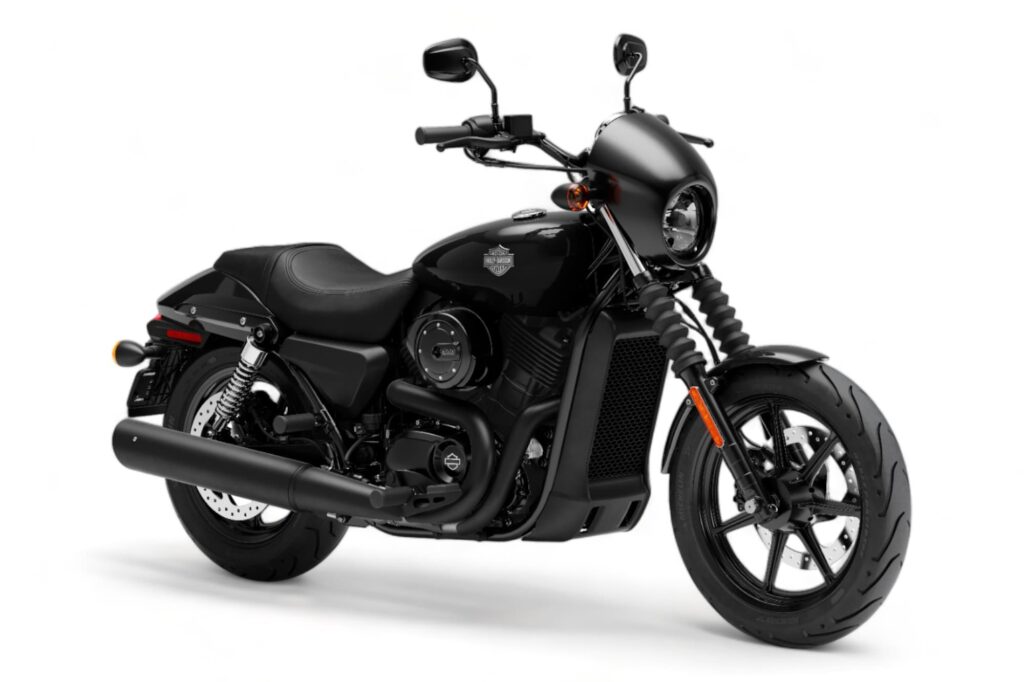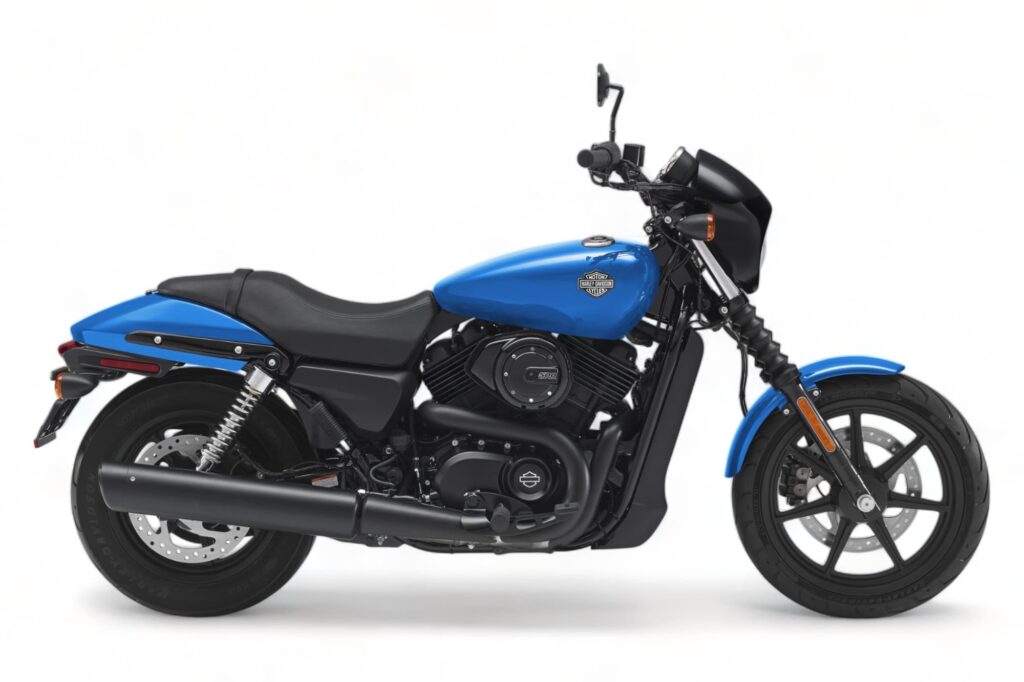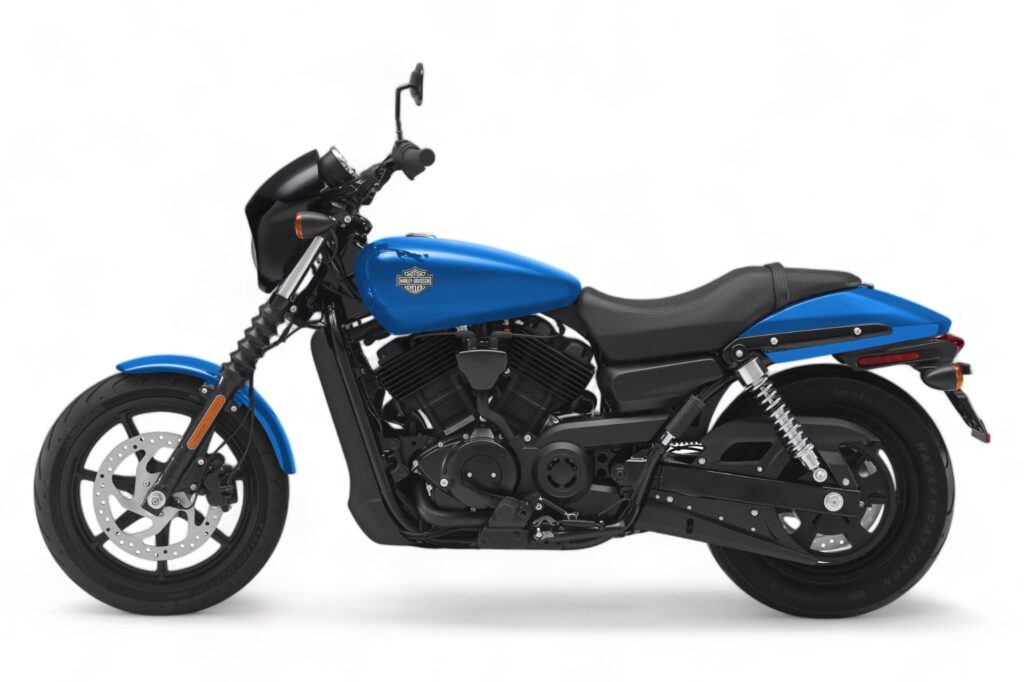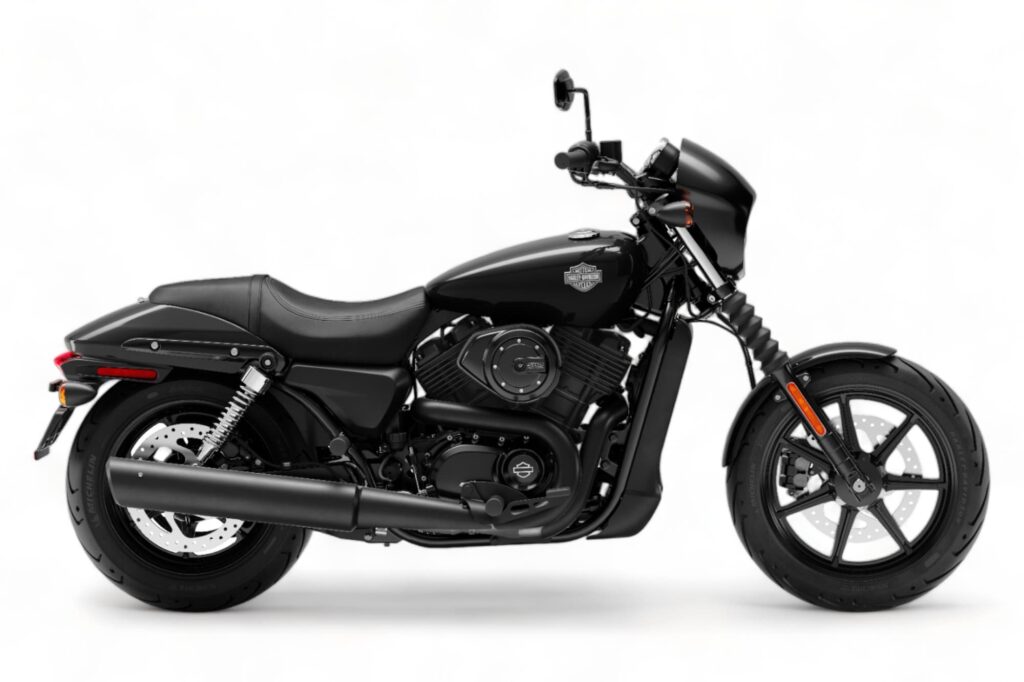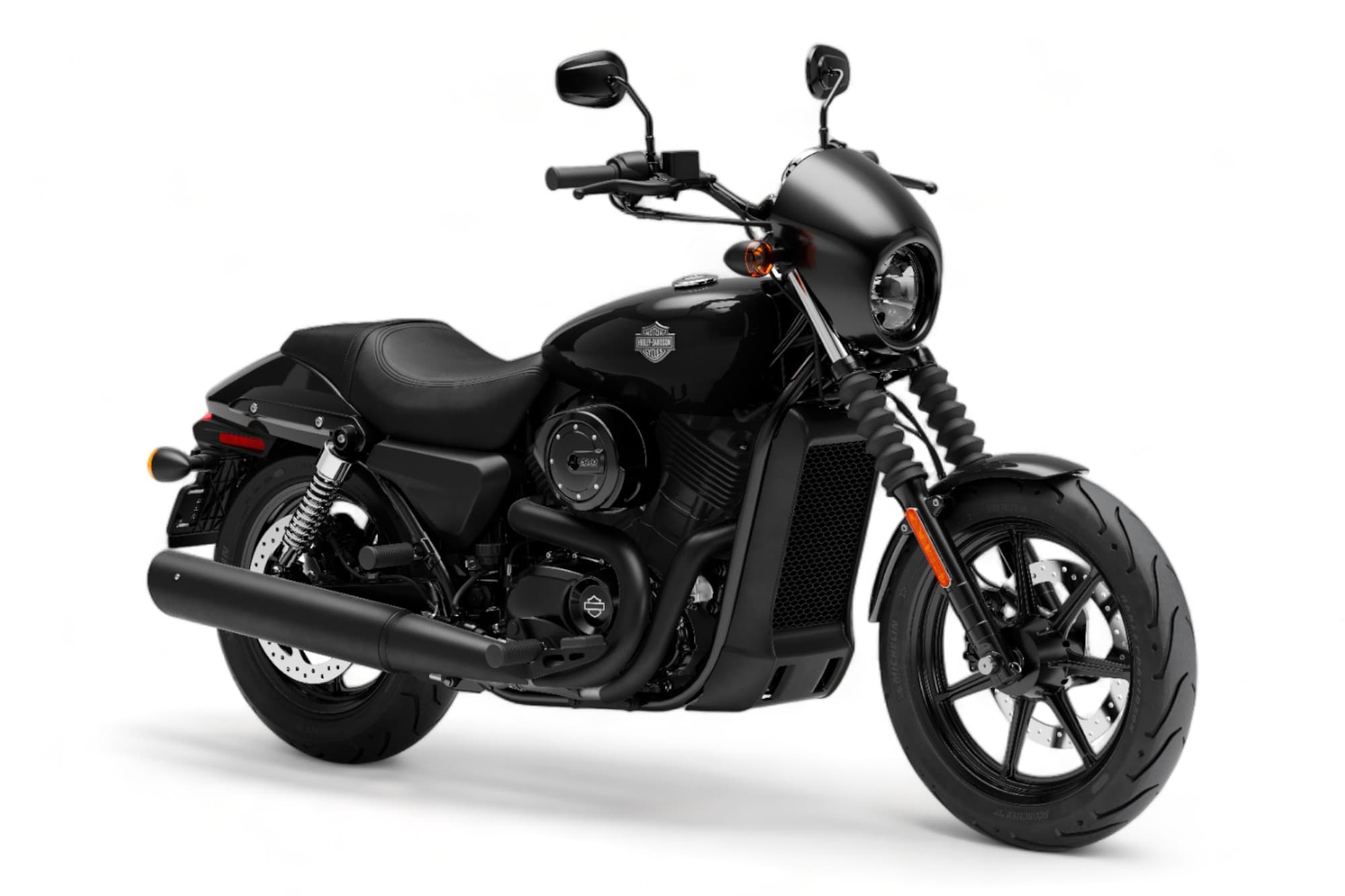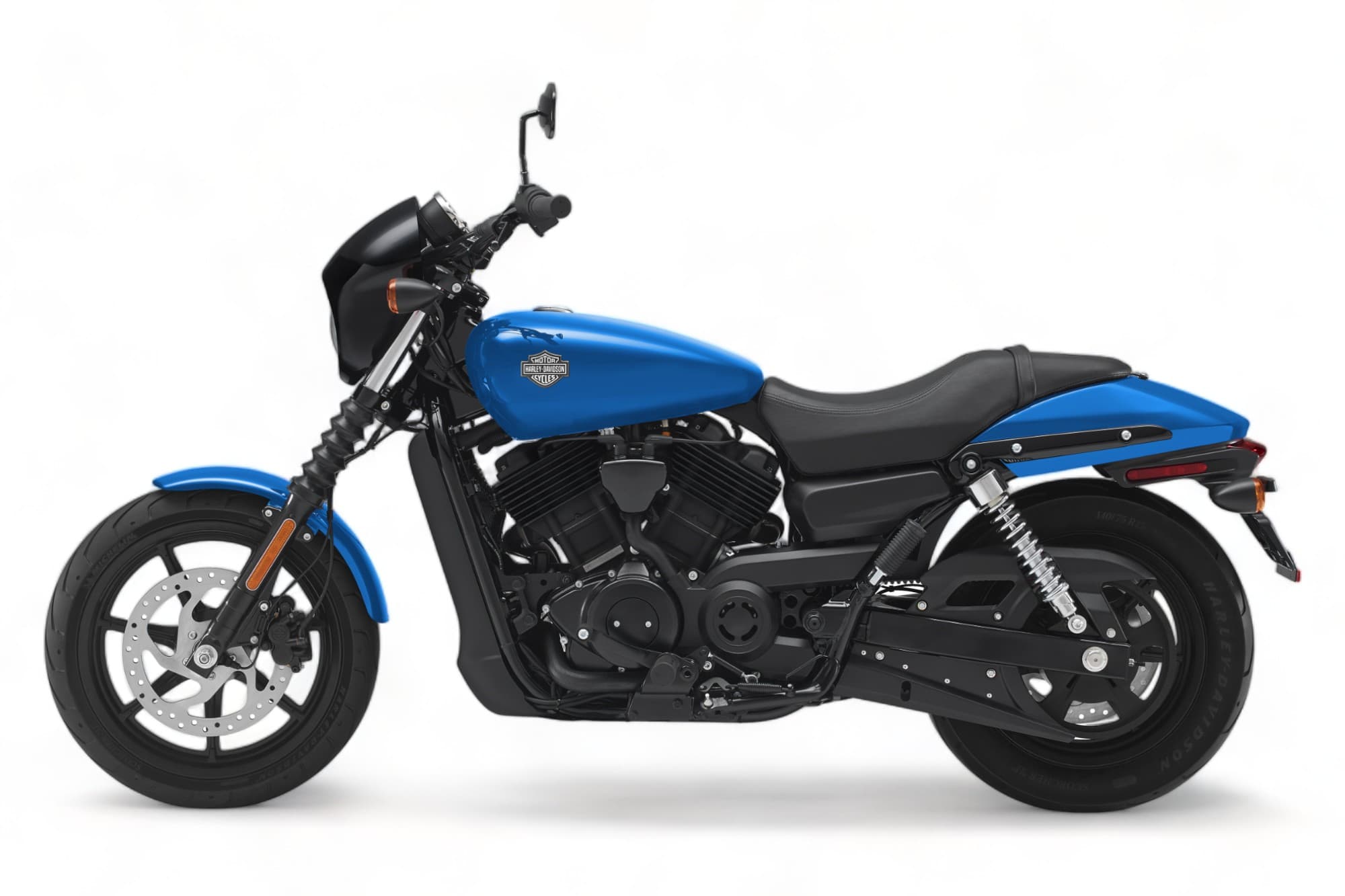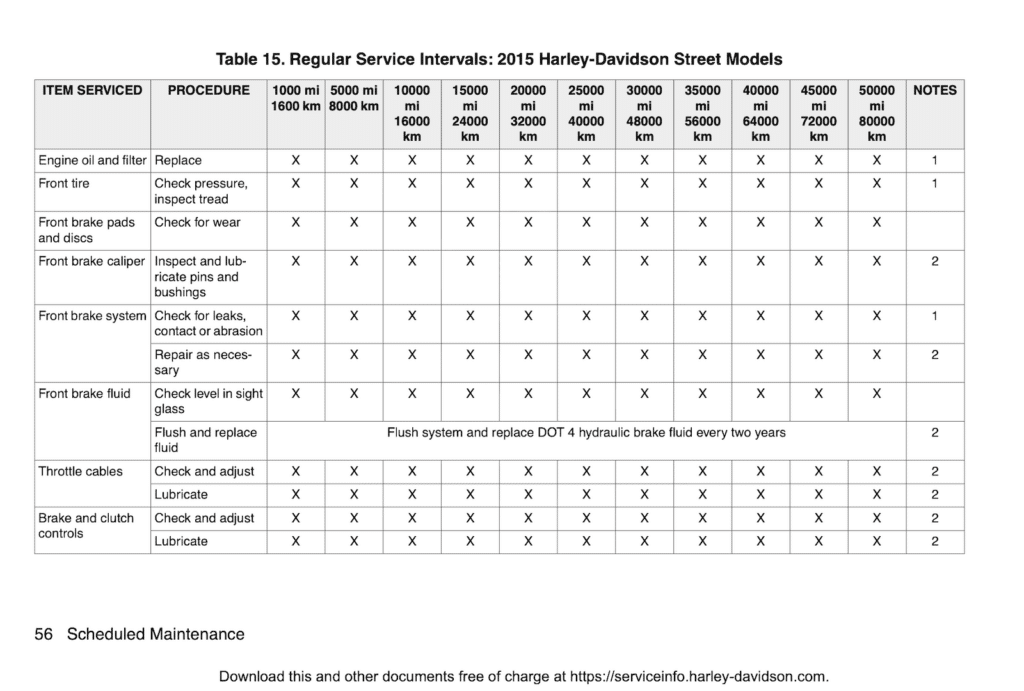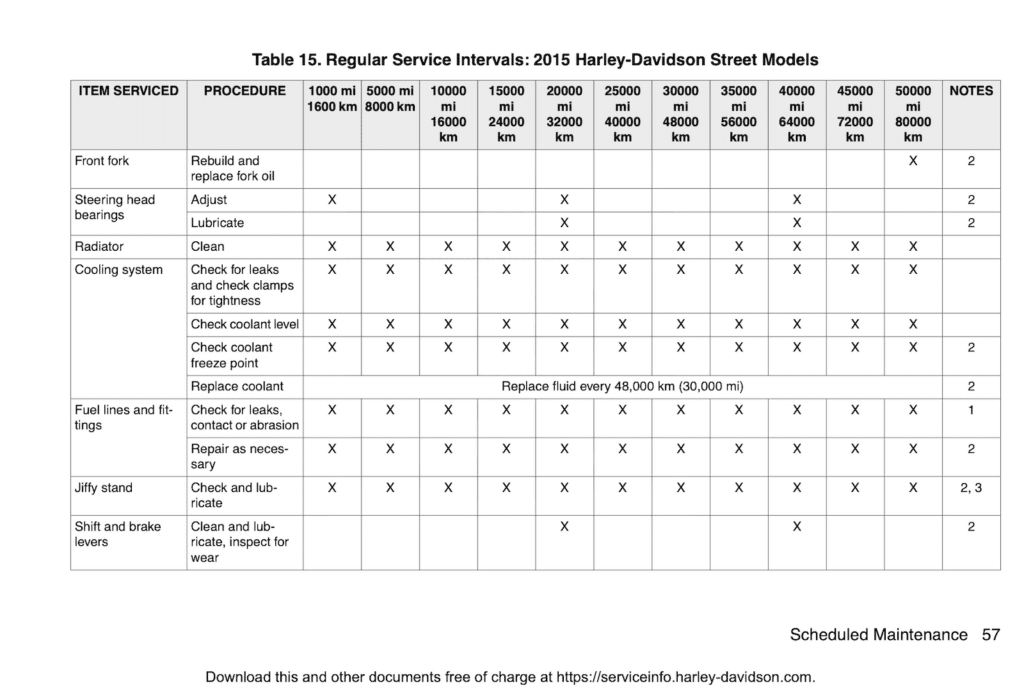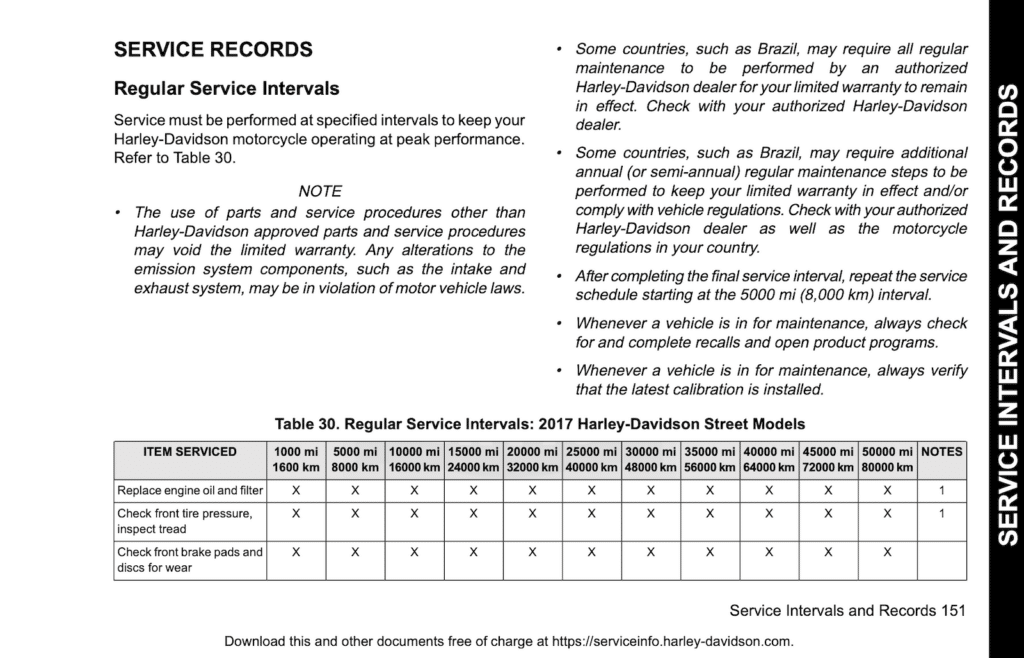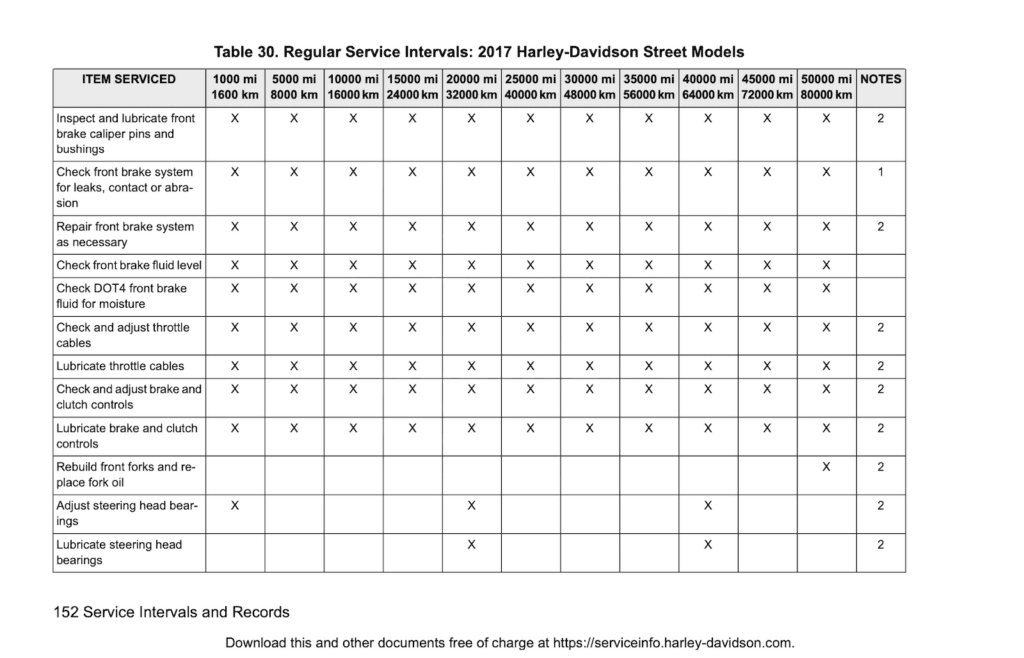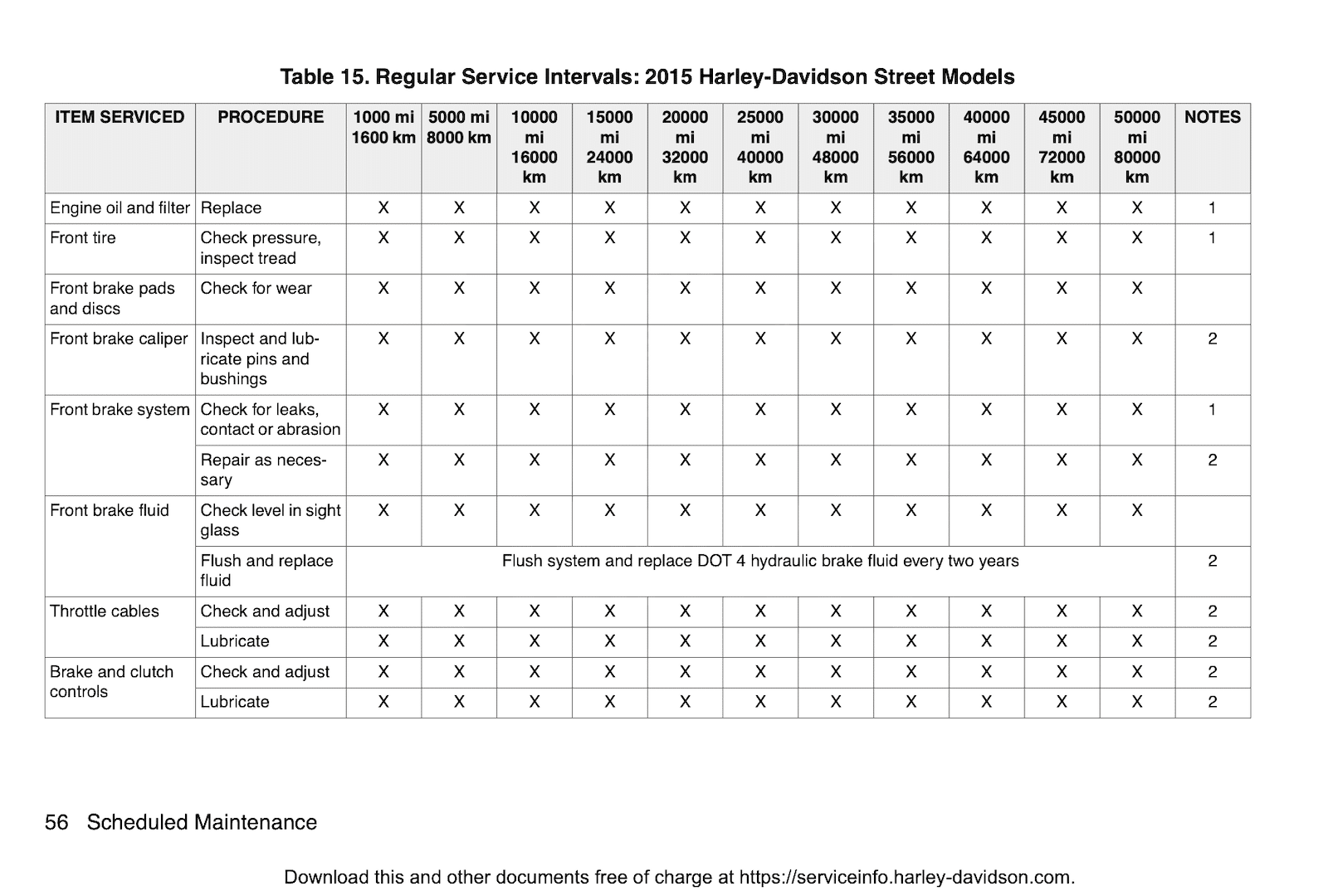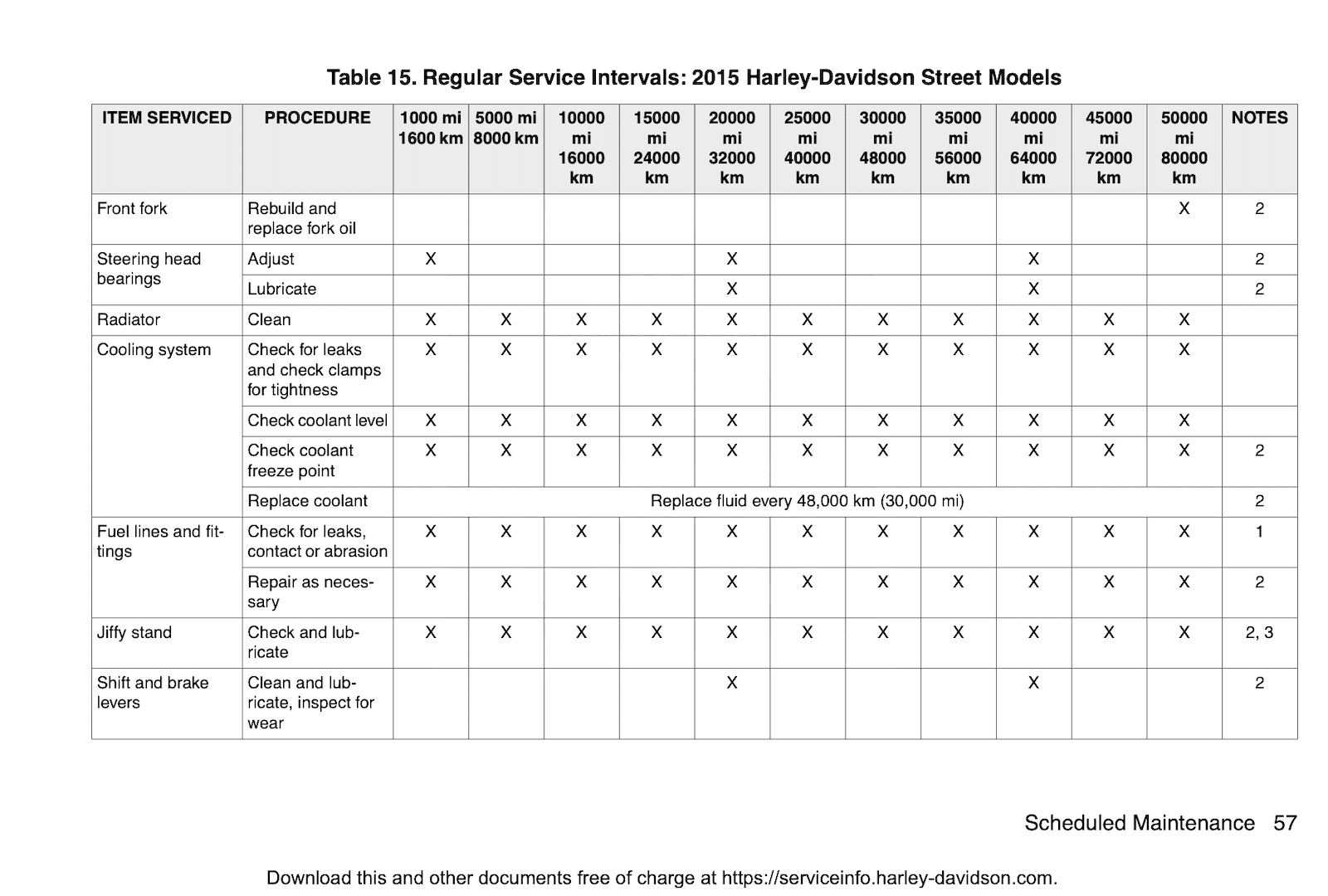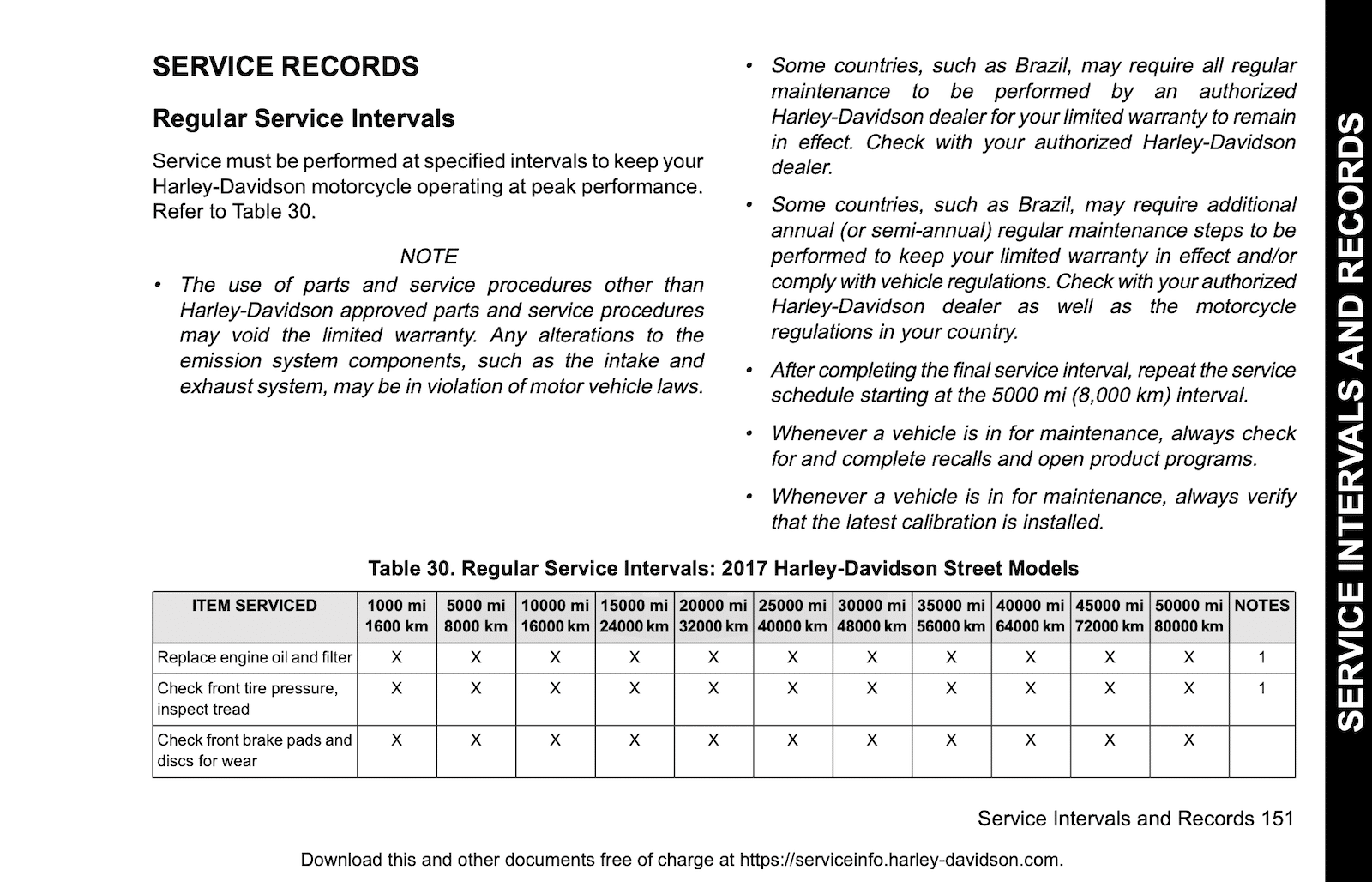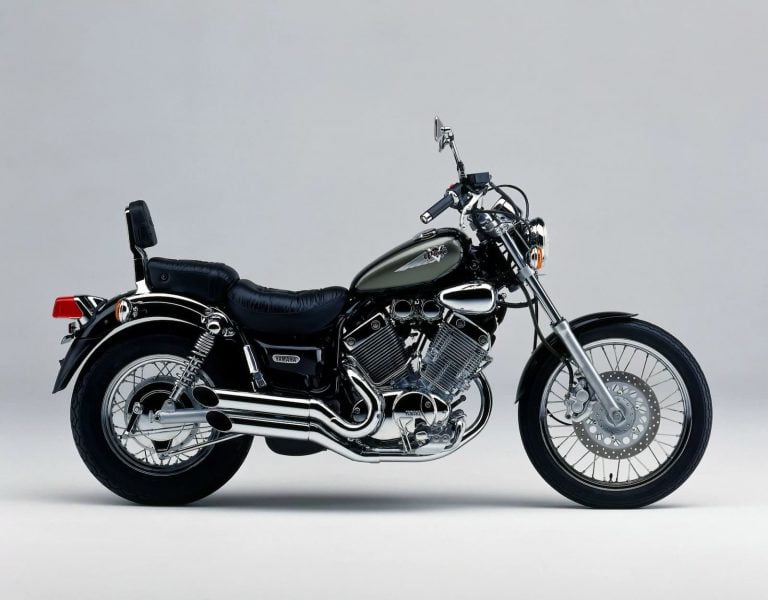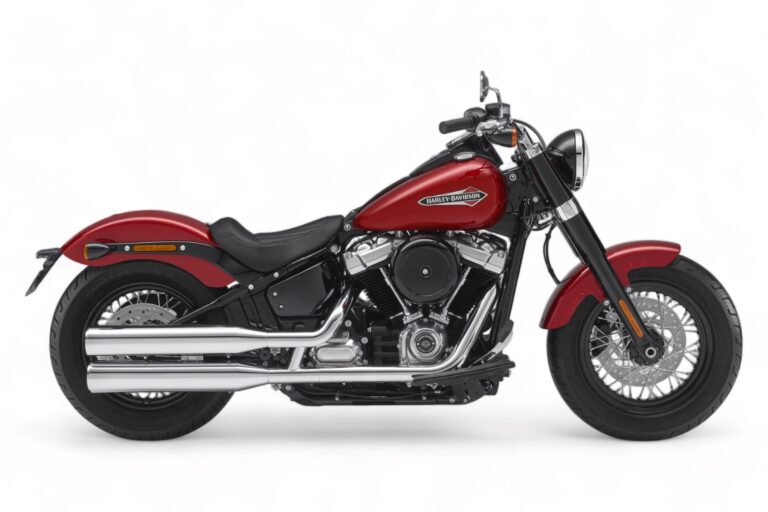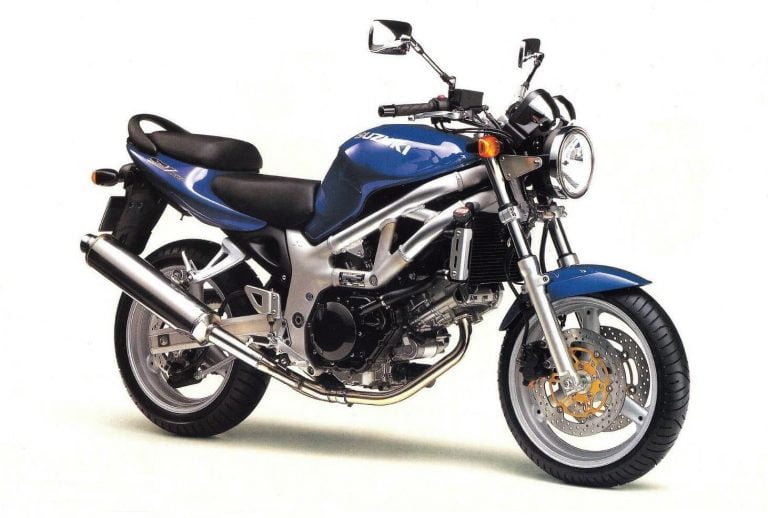Harley-Davidson Street 500 (2015-2020) Maintenance Schedule / Service Info
This is the maintenance schedule plus additional service information for the Harley-Davidson Street 500, one of a pair of modestly-powered twins offered by Harley-Davidson in 2015.
The Harley-Davidson Street 500 is based on a 494 cc version of the liquid-cooled Revolution X V-twin engine. With its mild 10.5:1 compression ratio, the Street 500 makes a low-end torque-optimised peak torque of 29.5 lb-ft (40 Nm) at 3750 rpm.
The final drive is via a 6-speed transmission and belt.
Other bikes in the Street range include the XG750 (Street 750) and later-released XG750A (Street Rod).
This site has links for things like oil and spark plugs from which we earn a commission (which unfortunately nobody can save, not even us). If you appreciate this work, then please use those links. Thanks!
Harley-Davidson Street 500 (XG500) Service Intervals
Overall, the Harley-Davidson Street 500 (XG500) has 5,000 mile / 8,000 km or 1-year service intervals. At each of these periods, whichever comes first, change the oil and filter, and do a host of other checks on the motorcycle (listed below in the service schedule.
The major service (the valve lash adjustment) is every 15,000 miles or 24,000 km (with no time component). While the Street 500’s Revolution X engine doesn’t have hydraulic valve lash adjusters (as do most other big Harley engines), the valve clearance check and adjustment procedure is simple, as you can do it with the camshafts in place. This is because the engines have a single overhead cam design, and the valve adjustment is via a screw-and-locknut type adjustment. The only complication is that there are two cylinder heads.
Aside from that, maintain your XG500’s fluids regularly, replacing your brake fluid and your coolant per the schedule.
The Street 500’s final drive is a belt (this aspect of it is classic Harley!), so that aspect of maintenance is easy. Just check it for wear and tension and adjust as needed.
Maintenance schedule for the Harley-Davidson Street 500
Below is the service schedule for the Harley-Davidson Street 500 (XG500). This comes from the owner’s manual, but has been clarified for legibility, with some parts specific for the 500 model.
For simplicity, the schedule is broken into two sections:
- The maintenance schedule of major items like oil changes, spark plugs, and valve service, and
- The “Annual inspection” checklist
Major Items Maintenance Schedule
Below is the schedule of major items to be serviced on the Harley-Davidson XG500.
Notes
- The break-in period has passed (the XG500 is no longer made), so that part of the schedule is omitted.
- If an item (e.g. oil changes) has to be serviced at a certain distance or time, follow the earlier of the two.
- At the end of the schedule, keep repeating it in the pattern shown.
| mi x 1000 | 5 | 10 | 15 | 20 | 25 | 30 | |
|---|---|---|---|---|---|---|---|
| km x 1000 | 8 | 16 | 24 | 32 | 40 | 48 | Every |
| Annual service checklist (see below) — Perform all items | ✓ | ✓ | ✓ | ✓ | ✓ | ✓ | Year |
| Engine oil — Replace (Harley recommends H-D 360, or a 20W-50 engine oil with CH-4 or above classification, e.g. Mobil 1 20W-50) | ✓ | ✓ | ✓ | ✓ | ✓ | ✓ | Year |
| Oil filter — Replace (HF175) | ✓ | ✓ | ✓ | ✓ | ✓ | ✓ | Year |
| Air filter, — Inspect, and clean/replace if required (HD-4915, different from other Street models) | ✓ | ✓ | ✓ | ✓ | ✓ | ✓ | More often if riding in severe conditions |
| Valve clearances (valve lash) — Inspect, adjust as necessary | ✓ | ✓ | More frequently in severe conditions | ||||
| Spark plugs — Replace (NGK CR9E or CR9EIX for iridium plugs) | ✓ | 2 years | |||||
| Brake fluid (front and rear) — Replace (Castrol DOT 4) | 2 years | ||||||
| Coolant — Replace (Harley-Davidson Extended Life Coolant, or an equivalent OAT coolant, e.g. Zerex G30) | ✓ | 30,000 mi (48,000 km) | |||||
| Shift and brake pedals — Clean and lubricate (lithium soap-based grease), and inspect for wear | ✓ | ||||||
| Steering head bearings — Lubricate | ✓ | ||||||
| Rear fork bearing — Inspect | ✓ | ||||||
| Rear shock absorber bushings — Inspect for wear and cracks | ✓ | ||||||
| Front fork — Rebuild (disassemble, inspect, rebuild, replace fork oil) | 50,000 mi (80,000 km |
Annual Service Checklist
Below is the annual service checklist for the Street 500 / XG500. Do these checks at every service, annual or at distance intervals.
Note — Items marked “Annual” need to be done annually as well as at distance intervals. The others don’t need to be done at an annual service if no mileage has been done.
| Harley-Davidson Street 500 / XG500 Annual Inspection checklist | Annual |
|---|---|
| Brake systems — Inspect for leaks, contact, or abrasion. Repair as necessary | ✓ |
| Brake fluid, front and rear — Check moisture content. Replace if over 3%. (use Castrol DOT 4) | ✓ |
| Fuel lines and fittings — Check for leaks, contact, or abrasion. Repair as necessary | ✓ |
| Front and rear tires — Check pressure and tread. Adjust or replace if necessary | ✓ |
| 12-volt battery — Check terminal torque, connection cleanness, lubricate terminals with contact lubricant | ✓ |
| Exhaust system, fasteners, and shields — Check for leaks, cracks, loose or missing fasteners/shields | ✓ |
| Fuel cap lock — Lubricate | ✓ |
| Drive belt and sprockets — Inspect condition and tension, adjust as necessary | |
| Brake pads and discs, front and rear — Inspect for wear, replace if necessary | |
| Brake caliper pins and bushings, front and rear — Inspect and lubricate (The XG500 has a single front disc and 2-piston sliding caliper) | |
| Brake fluid, front and rear — Check level, top up as necessary (use Castrol DOT 4) | |
| Brake and clutch controls — Check, adjust, and lubricate (Use Protect all cable life) | |
| Throttle cables — Check, adjust, and lubricate | |
| Cooling system — Check for leaks and clamps for tightness | |
| Coolant — Check level and freeze point. Replace as necessary (Zerex G30) | |
| Radiator — Clean | |
| Jiffy stand — Check and lubricate | |
| Electrical equipment and switches — Check operation | |
| Road test — Verify components and system functions |
Adjusting Valve Clearances
The major service for the Street 500, as with most motorcycles (other than those with self-adjusting lifters) is the valve service.
The Street motorcycles all have mechanical valve lifters, so you need to check and adjust the valve clearances periodically.
To adjust the valve clearances, follow this procedure.
- Remove the ground cable from the frame stud for safety.
- Loosen and move the fuel tank backwards to increase working room, installing a wood brace to hold it.
- Pull the spark plug leads
- Remove the valve cover bolts (8mm wrench)
- Remove the air cleaner assembly (check the cleaner at the same time), and the breather assembly.
- Protect the valve cover with a cloth, lift it, and remove it.
- Clean debris away from spark plug and remove plugs.
- Jack up the motorcycle until the rear wheel is free
- Rotate the wheel forward. Find the TDC — arrow on the camshaft sprocket should be pointing up.
- Use feeler gauges to measure the clearances.
Target clearances for XG500 are below.
| Valves | mm | in |
|---|---|---|
| Intake valves | 0.13-0.18 | 0.005 -0.007 |
| Exhaust valves | 0.18-0.23 | 0.007-0.009 |
If the valves are out of spec (or at the loose end of the range), tighten them to the tightest end of the range. Use a 10mm tappet lash adjustment tool along with a clearance gauge. After setting the clearance, tighten the locknut, and re-check the thickness.
When replacing the cover, use a new gasket if necessary. Then re-install all the components in the reverse order.
The video below (starting at 19:07) is an excellent reference and is applicable to the Street 500, Street 750, and Street Rod.
Drive Belt Maintenance
While a drive belt is low maintenance, Harley-Davidson recommends you regularly check the belt for wear or damage as part of the pre-ride checklist.
At every service, you also have to check drive belt deflection, using a standard belt tension tool.
Follow this procedure for checking belt tension on the Harley-Davidson Street 500.
- Put the motorcycle on its side stand and in neutral.
- Find the belt deflection measurement window on the side of the motorcycle. Use a belt tension tool to push up on the drive belt in this area with a pressure of 10 lb / 4.5 kg.
- Measure the belt deflection. Each gradation is 1/16 in (1.6 mm)
Target belt deflection for the Street 500 (XG500): 12.6-15.9 mm (0.5-0.62 in) (8-10 gradations)
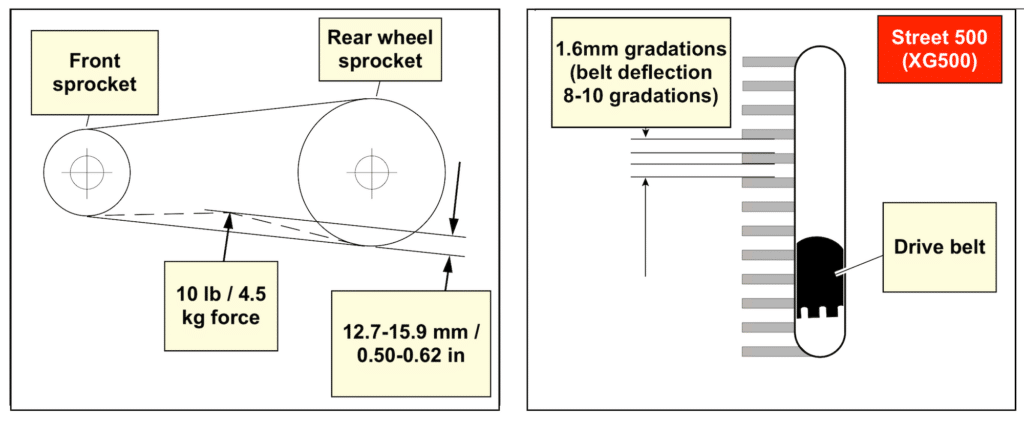
If the belt is out of spec, then you need to adjust it (which usually means increasing the belt tension). Generally speaking, the procedure is as follows:
- Elevate the rear wheel using a stand. (You take the tension measurements with the wheel on the ground, but adjust the tension with the wheel elevated.)
- Use a breaker bar to loosen the rear axle.
- Use a small wrench to turn the belt tension adjusters on either side of the bike. Make small changes — a 1/4 turn can make a huge difference. You have to lower the motorcycle again to measure the deflection with the weight on the wheel again.
- Make sure you tighten the nuts the same amount on each side. Check the belt and make sure it’s in tension and aligned.
- Tighten the rear axle to 96-104 lb-ft or 130-141 Nm with a large torque wrench.
Tire Sizes and Pressures
The Harley-Davidson Street 500 ships with a 17/15-inch tire combination. The XG500 ships with Michelin Scorcher tires in Western markets (MRF tires in India), but you can fit any road tires.
| Wheel | Tire size | Tire pressure (cold) |
|---|---|---|
| Front | Michelin Scorcher 11 100/80-17 M/C 52H India: MRF Zapper 100/80-17 M/C 52H | 34 psi / 234 kPa MRF Zapper tire: 30 psi / 207 kPa |
| Rear | Michelin Scorcher 11 140/75R15 M/C 65H India: MRF Zapper 140/70-15 M/C 67H | 42 psi / 290 kPa MRF Zapper tire: 40 psi. 276 kPa |
Naturally, adjust tire pressures to suit your conditions and riding style.
About the Harley-Davidson Street 500 (XG500)

Harley-Davidson initially released the Street 500 along with its bigger sibling, the Street 750. The bikes didn’t both make it to all markets. Some markets favour the smaller, due to licensing restrictions for learners, and some favour the larger. Nonetheless, they’re very similar — even many of the drivetrain specs are the same.
The Street 500 and the Street 750 are both based on a small-capacity Revolution X motor, an engine that shares a name with the motor from the V-Rod (the Revolution). Like the V-Rod’s motor, the Revolution X is a liquid-cooled high-revving engine with good power output for its capacity. However, this one isn’t built by Porsche, and is quite a bit smaller.
The Street 500, with its mid-spec and modest power output, is supposed to be an everyday urban kind of motorcycle. It’s quite low in power, and also quite low in torque — it makes about as much torque as a Ninja 400, but with less top end. It’s also heavy at 233 kg / 514 lb, has basic suspension and brakes, and in general, isn’t going to light the world on fire. So what do you get for your money? You get a V-twin road, and a Harley-Davidson badge.
The Street 500 is an everyday street cruiser kind of motorcycle, somewhat like a Honda Rebel 500 or Triumph Bonneville T100. It makes everyday riding fun. It’s stylish (without being iconically so like its air-cooled brethren like the Sportster Iron 883), easy to get along with, and easy to service.
Anyone considering the Street 500 is likely to also consider the Street 750 (if it’s available in your market) and the Street Rod.
Here’s how the major differences break down. (Note: These are specs from Harley-Davidson’s media site, e.g. here for the 2015 500, referring to European specs for the power output. However, the Street 500 never made it to Europe, so that comes from an Australian review site. Some specs differ from those in the manual or other official sources, but only by small degrees.)
| Model | Street 500 (XG500) | Street 750 (XG750) | Street Rod (XG750A) |
|---|---|---|---|
| Years | 2015-2020 | 2015-2020 | 2017-2020 |
| Displacement | 494 cc | 749 cc | 749 cc |
| Bore / Stroke | 69 x 66 mm | 85 x 66 mm | 85 x 66 mm |
| Compression ratio | 10.5:1 | 11.0:1 | 12.0:1 |
| Fuel requirement | Regular: 87 (PON) / 91 (RON) | Regular: 87 (PON) / 91 (RON) | Premium: 91 (PON) / 95 RON |
| Peak power (from Europe specs) | 36 PS / 27 kW @ 7100 rpm | 58 PS / 43 kW @ 8000 rpm | 70 PS / 52 kW @ 9000 rpm |
| Peak torque | 29.5 lb-ft / 40 Nm @ 3750 rpm | 44 lb-ft / 59 Nm @ 4000 rpm | 47.2 lb-ft / 64 Nm @ 4000 rpm |
| Front brakes | Single 300 mm disc, 2-piston floating caliper | Single 300 mm disc, 2-piston floating caliper | Dual 300mm brakes, 2-piston floating calipers |
| Wheel size combo | 17 / 15 inch | 17 / 15 inch | 17/17 inch |
| Suspension travel (F/R) | 140 / 90 mm 5.5 / 3.5 in | 140 / 90 mm 5.5 / 3.5 in | 132 / 117 mm 5.2 / 4.6 in |
| Lean angle (L/R degrees) | 28.5 / 28.5 | 28.5 / 28.5 | 37.3 / 40.2 |
| Running weight | 233 kg / 514 lb | 233 kg / 514 lb | 238 kg / 525 lb |
The modest power output and heavy weight of the Street 500 make it a popular learner but an unattractive long-term bike. Riders who stay within the ecosystem look towards more powerful bikes with neutral riding positions, like the RH975 Nightster, for example.
Reference — Screenshots from the Manual
The above information came from the owner’s manual for the “Street” motorcycles for 2015, checking it against the manual from 2017 and 2020. See a few screenshots below.
Additional part numbers/information came from several online catalogues.
You can download manuals from Harley Davidson here, though you need to log in.
